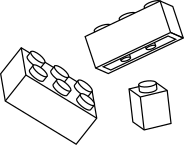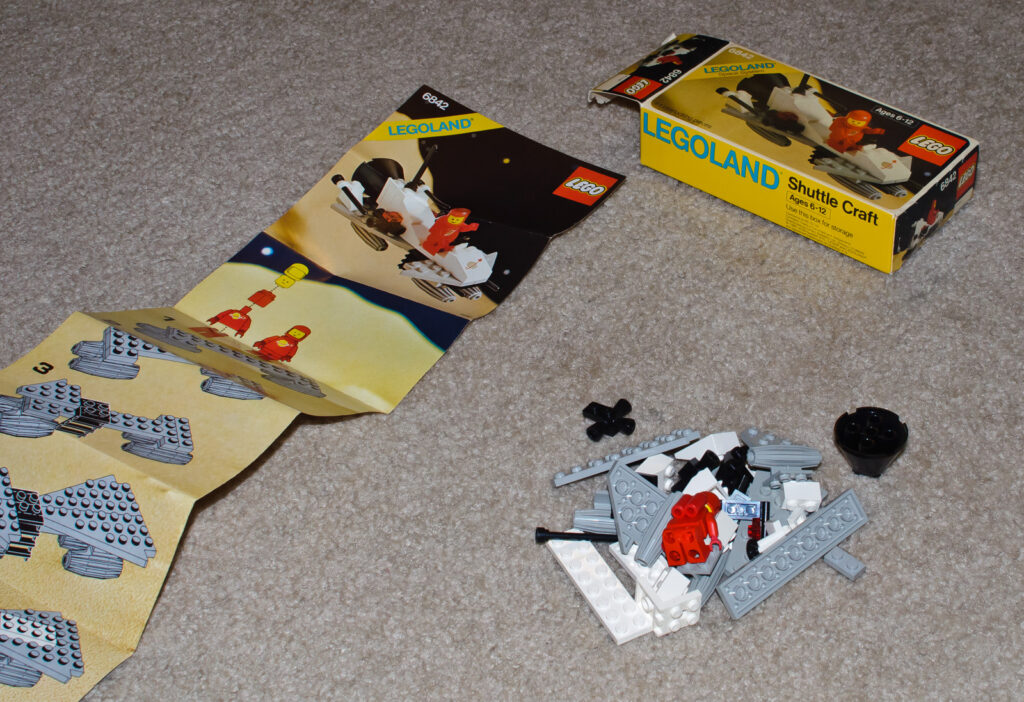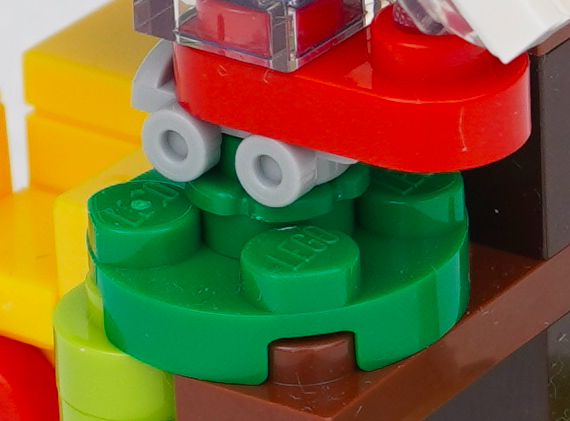Intellectual Property in Ikego
Parts are open.
Products can be closed.
→ The key to Ikego is Open Parts. Anyone can use, make and sell them for any purpose without conditions or restrictions.
But how can this work commercially? Aren’t monopolies essential for functioning businesses? Fortunately, Ikego is not the first project to do this. Did you know that LEGO® bricks are open? They are! Their patents expired a long time ago. Today many cool companies produce and sell the very same bricks. But LEGO is still the most valuable toy company in the world, and it is growing very fast. Why? Because individual sets built from open bricks can still be closed and exclusive.
The building blocks are open ↓
 .
.
Fully open bricks. Their original patents published 1961 have expired. Anyone can make and sell them. And many do.
Models built with them can be closed ↓

Individual sets and models can commercially monopolised using intellectual property rights. Here are the existing intellectual property rights, what they protect and how they apply to a LEGO model.
Trademark: protects brand names and logos. LEGO™ is a protected trademark. You can make the same bricks but not market them as “LEGO bricks”. LEGO makes also Star Wars™ sets. Another trademark LEGO pays to use. Only LEGO sells Star Wars sets. The LEGO logo is on top of each stud of a brick made by LEGO making it recognizable among other bricks.
Copyright: protects “works of art”. The box art, product shots, instructions and product descriptions are protected by copyright. You can sell all the bricks of an existing LEGO model. But you can’t use LEGOs marketing material for it.
Design Rights: protect the visual appearance of a physical product. So the unique shape and appearance of a model built with bricks is potentially protectable with design rights. You made a cool spaceship using open bricks? Monopolize it with design rights. So nobody can sell a ship that looks like yours.
Patents and Utility Models: Protect how something works – how it functions. If the model would do something new – for example generate electricity in a new way – this could be protected with a patent or utility model. This doesn’t make much sense for LEGO bricks but could make sense for products using Ikego parts when they introduce new functionalities or innovative ways to solve everyday problems.
↑
all of these work for Ikego models.
.
Yes. All intellectual property rights that can close products/models are always welcome and supported in Ikego! At the product level, Ikego is no different from the usual design world.
.
Parts need to be open
The magic of the Ikego idea lies in the creative reuse of multipurpose parts. In order for this to unfold in all imaginable ways, these parts must be completely open – open as in open source.
Everyone in the ecosystem, large and small, needs to be able to use them for everything (commercial and non-commercial) immediately and without hurdles. Imagine if every time a small workshop wanted to use a part for a commercial project, they had to contact the rights holder of the component and negotiate a licensing agreement. That would slow the system down or make it impossible. Without freedom no movement is possible.
This means that all parts in the system are free to use. But it also means that when you, as a designer, add a new part, that part must be made open so that others can enjoy the same freedoms with your part as you do with all the existing parts in the catalogue.
Depending on whether you are adding an off-the-shelf part or a part you made yourself, you will need to choose one of these options:
1. Off the shelf part
If you pick an off the shelf part, try to pick something that is common, easy to get and ideally has been around for a long time. If a part is older than 25 years, it is should be prior art – this means that any existing protection should have expired and anyone can use it without permission. In your documentation of the part write: “I bought this part off the shelf. It might be prior art but I don’t guarantee this.” You’ll say “it might be” because we don’t expect a designer to check if it really is. We will look into that.
2. Newly designed part
The moment a designer creates a new part, it is considered to be an “own part”. This means that it cannot be ruled out with certainty that the designer has a property right in it. Even if it is as simple as a disk with a hole in the center. In order to give legal certainty to all those who want to work with the new part, the designer must place the new component under an open licence – the “Ikego Public Promise” license. In this way, the designer is attempting to waive any proprietary rights the designer has or may have. The part should be as free as if it were in the public domain. So anyone can use it without fear of legal consequences.
Click here to read more about the “Ikego Public Promise” license.
.
The Ikego Public Promise (IPP) is a public license.
What is a public license? Let’s first understand what a regular license is.
A regular license usually involves two parties. One party that owns something and another party that wants to use it. For example, Disney owns the “Star Wars” trademark. If LEGO wants to use it, it signs a licensing agreement with Disney, which may include LEGO paying Disney for the use of the trademark. The result is LEGO® Star Wars® sets.
A public license is a license agreement with the whole world – with everyone on the planet at once. Because you can’t meet everyone on the planet, you need to put the licence next to the work it applies to. In your public license you say what others can do with the work – for example, copy it, use it, remix it – and what you expect them to do in return – for example, give you credit. An example is the Creative Commons licenses used by the Wikipedia (stated at the bottom of each page). Every contributor knows that he or she publishes all contributions under this license.
The Ikego Public Promise aims to work like this. In it, the designer guarantees to everyone in the world that he or she will never claim intellectual property rights to the part and will never try to limit what others can do with it. Everyone is given the opportunity to work freely with the part without any restrictions or conditions. The Ikego Public Promise is completely unconditional.
Why completely unconditional? Because any condition, no matter how small, makes it difficult for others to use the part and creates legal risk. Yes, even attribution is often difficult. Where to put it? If the licensor doesn’t like the way I give attribution, will I get sued? Every complications would slow down or prevent the use of Ikego parts and make it less convenient. Unconditional enables creative freedom for everyone – including you.
To put it even more clearly: The Ikego Public Promise is there to protect the world from the designer of the part. So the world can enjoy the same freedoms with the new part as the designer enjoys with all the parts already in the catalogue. This is the way Ikego wants to work. As a designer, make sure you understand this and feel comfortable with it before you contribute.
*
.
✼
Btw. it goes without saying designers should not to the best of their knowledge copy/reinvent innovative parts that are available on the market and are potentially still closed. Old and common is great.
–
Products can be closed
As explained above in the example with LEGO®: Products consisting of open parts can of course be closed. And Ikego encourages this.
How to close it? Depending on the model and your geographical location, there are different intellectual property rights that can be considered.
1. Design Rights: Broadly speaking, design rights protect the visual appearance of something. They are usually tied to a very specific look – defined colours and curves. For example, an orange plastic chair with rounded edges and clearly defined angles. If you have made an Ikego model, you can apply for design rights and send in the necessary descriptions. You’ll get a commercial monopoly on your design that applies to all executions of your model that meet the descriptions of your design rights.
However, it should be noted that the tolerance methodology of Ikego probably allows for other commercial makes your model. Someone could for example make the same chair in black with sharp edges and slightly different angles. If it looks too different from the descriptions in your design rights, you don’t have a say here. This is already common practice in the design world. The Eames chair was not the only chair with a headrest and armrests. There were many ‘clones’ with minor variations, all of which were recognised as independent designs. You can protect “your Eames chair” within the Ikego world. Specific executions of a model will be the heroes of this world.
If you want to protect your model more widely and exclude all makes of the model, you would need to go for the next IP option: utility models or patents.
2. Patents & Utility Models: They protect what something does or how it works. It is about functionality not about looks. To get this protection your invention needs to be new! Where can this play a role for Ikego? Imagine someone makes a technical invention using Ikego parts. For example: One could imagine that the idea to combine the parts 012.1, 033.1 and 014.1 to a “sock dispenser” is protectable with a utility model. Socks from a dispenser on a wall is a new function – maybe. Every Ikego model is also a technical achievement in its own: It adds a new way of assembling Ikego parts into a working product. You can try to protect it. Ask your patent lawyer if there is potential.
 3. Trademarks: You can register a trademark easily. There are various ways to connect trademarks to physical objects. For example brand and product names can be registered as trademarks. “LEGO” and “Ninjago” are two registered trademarks of the LEGO Group. Fashion companies often print their brand names and logos on clothes. Why? Because patterns in fashion are hardly protectable. They are basically open from the start. Trademarks however are pretty easy to protect and enforce. So anyone can tailor a CUCCI shirt or jacket without any problem. But only GUCCI is allowed to print “GUCCI” on them. For Ikego this might be for example interesting when it comes to the quality of manufactured parts. Since Ikego parts are open they can be made by different companies. But if for example Vitra produces one of the parts in very good quality Vitra can also put their brand name on the part. From this customers can recognise that it is one of these fantastic parts from “Vitra”. LEGO bricks have the LEGO logo on the top of the studs. Bricks by other manufacturers can’t have the LEGO logo there. This enables a second hand market for “original LEGO” bricks.
3. Trademarks: You can register a trademark easily. There are various ways to connect trademarks to physical objects. For example brand and product names can be registered as trademarks. “LEGO” and “Ninjago” are two registered trademarks of the LEGO Group. Fashion companies often print their brand names and logos on clothes. Why? Because patterns in fashion are hardly protectable. They are basically open from the start. Trademarks however are pretty easy to protect and enforce. So anyone can tailor a CUCCI shirt or jacket without any problem. But only GUCCI is allowed to print “GUCCI” on them. For Ikego this might be for example interesting when it comes to the quality of manufactured parts. Since Ikego parts are open they can be made by different companies. But if for example Vitra produces one of the parts in very good quality Vitra can also put their brand name on the part. From this customers can recognise that it is one of these fantastic parts from “Vitra”. LEGO bricks have the LEGO logo on the top of the studs. Bricks by other manufacturers can’t have the LEGO logo there. This enables a second hand market for “original LEGO” bricks.

LEGO logo on top of studs
4. Copyrights: Copyrights is mostly for artistic works like text, images or software. They usually cannot be used to protect three-dimensional objects. However, texts and images of all kinds are protected. So in Ikego pictures you take of your work are protected. You receive copyrights automatically. No one will be able to use your work unless you give them individual permission or put a public license – for example the CC0, CC-BY or CC-BY-SA license – next to it. So your great marketing material only works on the page where you benefit from the sale.
↑
All these intellectual property rights can be combined with Ikego. Open parts don’t prevent monopoly based businesses. However we also want to state that protection is not a must do. We also welcome full open source hardware products!
–
DIY is always fine
Ikego tries to make designs that are easy to make. If you have some skills, you should be able to make many of the designs shared on this site. And you are allowed to. Did you know that in most jurisdictions around the world you are allowed to make even patented or otherwise IP-protected things for yourself? As long as you make it for your own personal use, it is perfectly fine. So if you have the skills, go for it. If you are not very handy → hire a local craftsman to make a design for you.
–
Footnote
¹ It is important to understand that intellectual property is governed by law and law is always local. So in each country these IP rights might work a bit different. They might even have different names or don’t exist at all. But to some extend there are similarities between most countries. And the information above might be a good starting point for your research.
DISCLAIMER
This page is NOT LEGAL ADVICE. We are no lawyers. Everything written on this page might be false. You need to check this with legal professionals. (And if they tell you something that is different from what is said here on this page please let us know.)
Image Credits
Lego Space – Set 6842 Shuttle Craft (7539329454).jpg, by InSapphoWeTrust, CC-BY-SA 2.0
